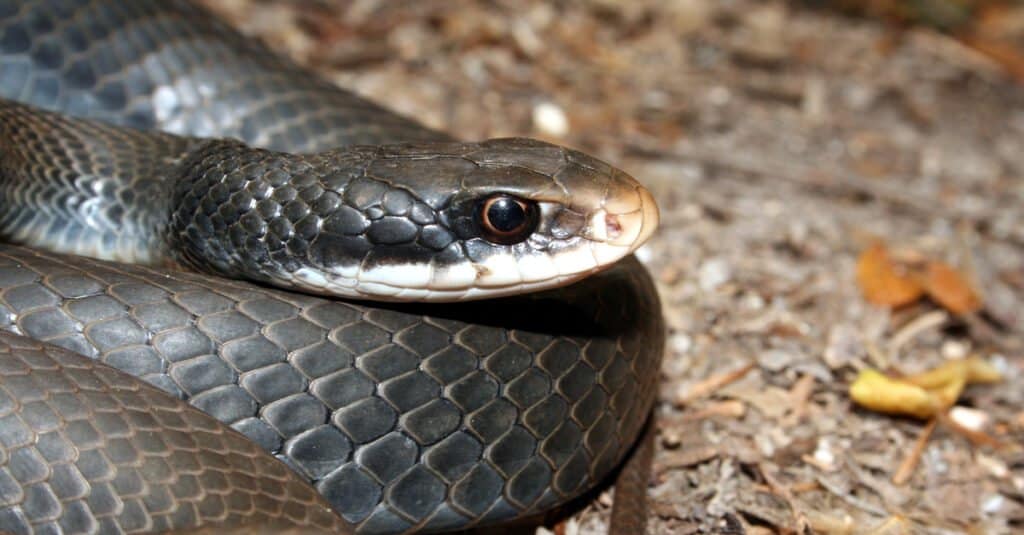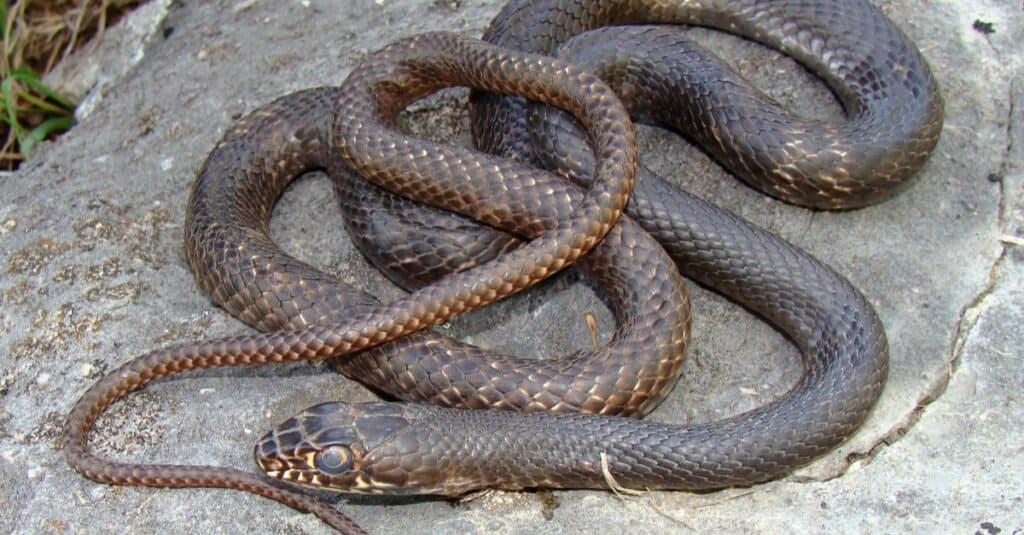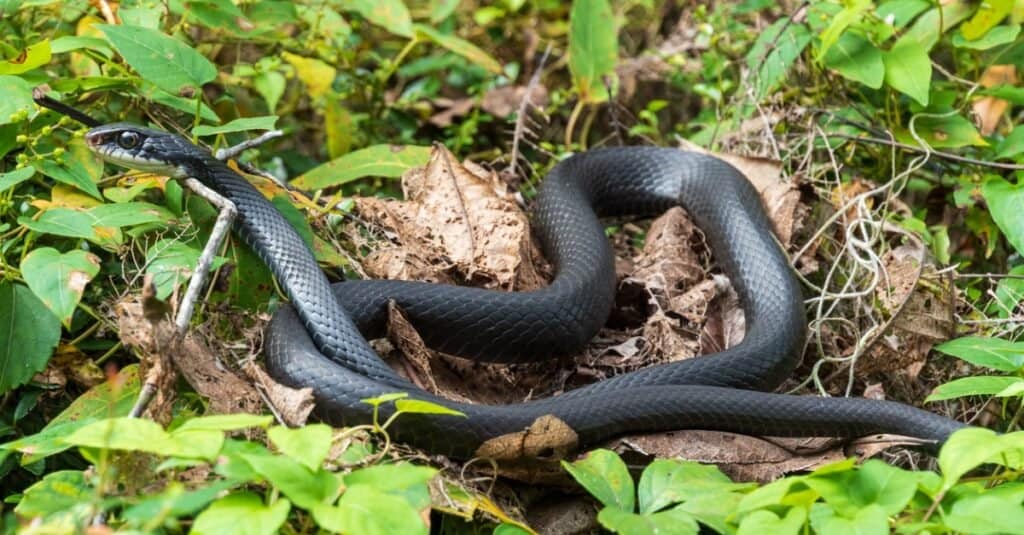Knowing the difference between some types of snakes is a helpful skill. The black racer and the coachwhip snake are found in many of the same places, and they’re a lot alike. What are some of the similarities and differences when comparing a coachwhip snake vs a black racer?
Black racers have their name because of their speed and black coloring, while coachwhip snakes look like a whip used to drive horses for coaches a century or more ago. Both are relatively harmless, though they can bite in rare circumstances.
Let’s examine the similarities and differences between these two snakes.
Comparing Black Racers and Coachwhip Snakes

| Coachwhip Snake | Black Racer | |
|---|---|---|
| Appearance | Grows to 8 feet in length and is slender | Also slender, but only grows to about 5 feet in length |
| Predators | Great horned owls and coyotes | Other snakes, mammals, and birds |
| Geographic Range | Across much of the southern United States and into Mexico. Doesn’t live past the 42nd parallel | Larger geographic range that reaches into Maine on the East Coast and into Canada on the West Coast. Not found in desert regions in the American Southwest |
| Venom and Threat | Nonvenomous | Nonvenomous |
| Speed | 4 miles per hour | Unverified reports of 8 to 10 miles per hour, more than likely about 4 miles per hour |
| Diet | Rodents, birds, lizards, amphibians | Rodents, birds, lizards, amphibians |
The Key Differences Between Coachwhip Snakes and Black Racers
The key difference between coachwhip snakes and black racers is that coachwhip snakes tend to be larger. In addition, black racers tend to have a darker coloration as well. Bother snakes share similarities as well. They’re in many of the same habitats, are both nonvenomous, and are slender snakes that are easily mistaken.
Let’s explore their differences in more detail.
Coachwhip Snake vs Black Racer: Appearance

Black racers have white chins and dark bodies.
©Psychotic Nature/Shutterstock.com
Coachwhip snakes can grow up to 8 feet long and are quite slender for their size. Black racers are also slender but only grow to about 5 feet in length.
Coachwhip snakes have a scale pattern that looks like a braided whip which again harkens back to its namesake. They have a white tail and a dark head, and their coloration washes across their body into one smooth blending of color.
On the other hand, black racers have white chins and dark bodies. Black racers have a more even black coloration as adults and are slightly thinner than coachwhips. Coachwhips have a tail that tapers at the end.
While black racers rarely weigh more than 1.2 pounds, coachwhip snakes can grow up to nearly four pounds at their maximum weight. That’s a distinctive feature when you consider their size differences.
Depending on the subspecies of coachwhip snakes, their fading coloration may be pink, red, or tan. They’re also known for their big eyes and small head. Black racers also have big eyes, but they’re almost always solid black with white chins. Coachwhips are reliably the same color as the foliage and ground that make up their main habitat.
Coachwhip Snake vs Black Racer: Predators
Coyotes, kit foxes, predatory birds, and raccoons all prey on coachwhips and racers, but bigger individuals may have better luck avoiding predators. Black racers are more vulnerable due to their size, but they put up a good fight. There is even a recorded incident of a black racer and a great horned owl killing each other in a predatory struggle.
Both the coachwhip snake and the black racer must be mindful of their eggs as they easily become a snack for foxes, raccoons, and other mammals if given a chance.
Coachwhip Snake vs Black Racer: Where Do They Live?
Coachwhip snakes and black racers generally like the same habitats, such as sandy areas, fields, and suburbs.
Coachwhips live in the southern USA from coast to coast and in southern Mexico. It has been observed that they do not populate areas around the Mississippi River. This range contains all six subspecies, each with a smaller territory within the coachwhip’s range.
Like the coachwhip snake, the black racer is a common snake found throughout its territory. It is also an umbrella term for a few black racer types. The southern black racer lives in the southern United States and as far north as Maine. It lives as far south as Guatemala. In short, racers have a range that extends both further south and north than coachwhip snakes.
The Similarities Between Coachwhip Snakes and Black Racers
Coachwhip snakes and black racers are similar in threat, diet, the time of day they come out, and being of least concern.
Let’s explore these similarities in detail.
Coachwhip Snake vs Black Racer: Venom and Threat

Coachwhips are nonvenomous and not aggressive.
©Matt Jeppson/Shutterstock.com
Coachwhip snakes are nonvenomous and very common. They’re considered by most to be harmless. They bite if cornered, and this can cause swelling and pain. If the wound is kept clean, it generally resolves itself quickly. Black racers are also nonvenomous and generally try to flee high-stress situations. They also bite when cornered.
Black racers and coachwhip snakes are more beneficial to humans than harmful. These snake populations are not out of control, and having a healthy population in the ecosystem, even where humans overlap, is a good idea. They control pest populations not only in yards but in fields, parks, and riverways.
There is a myth that coachwhips chase humans and lash them with their tails, which isn’t true. Like black racers, they will try to flee but become aggressive if cornered.
Coachwhip Snake vs Black Racer: Speed
A black racer and a coachwhip snake both typically move at about 4 miles per hour. That’s because they’re closely related snakes with similar body compositions. However, racers may be a bit faster, especially when threatened (they are named racers after all!), and there are unverified reports of them moving at a top speed of 8 to 10 miles per hour. That might not sound like much, but it’s among the faster speeds any snakes across the world are capable of. Both are very agile swimmers and climbers, which helps them escape predators and helps them stalk their prey.
Coachwhip Snake vs Black Racer: Diet
Both the coachwhip snake and the black racer are carnivorous, and they eat rodents, birds, lizards, amphibians, and insects. Their diets do not differ much from each other.
Where the snakes have overlapping territory, most notably in Florida, similar feeding habits affect the size of black racers while coachwhips remain unaffected. Black racers tend to be smaller, which suggests that the coachwhips access prey first due to their larger size.
Coachwhip Snake vs Black Racer: Are They Nocturnal?

Black racers are always out during the warmest parts of the day.
©iStock.com/Sunshower Shots
Neither coachwhip snakes nor black racer snakes are nocturnal. It’s common to run into black racers when doing yard work or moving outdoor objects, but they aren’t a nuisance. They help control rat and mice populations.
Coachwhip snakes and black racers are always out and about during the warmest parts of the day and hide in burrows they’ve made beneath objects or underground when it’s cool out. They brumate in the winter when it’s too cold to support their body functions.
Coachwhip Snake vs Black Racer: Are They Endangered?
The human population is the biggest threat to both the black racer and the coachwhip snake. Their habitat is often developed, and they’re killed at a high rate in suburban environments. They also end up as roadkill.
While some dangers exist for these snakes, it hasn’t been enough to hurt their overall success.
Coachwhip snakes are not endangered except in the state of Illinois. They still have substantial numbers in Arizona, Texas, and Florida. The IUCN Red List lists these coachwhips as least concern. Like coachwhips, black racers are also considered a matter of least concern.
Next Up
- Discover the largest coachwhip ever recorded
- 10 snakes in central Florida
- How long was the longest prairie kingsnake?
- Watch while an indigo snake eats a python
The photo featured at the top of this post is © Alexander Wong/Shutterstock.com
Discover the "Monster" Snake 5X Bigger than an Anaconda
Every day A-Z Animals sends out some of the most incredible facts in the world from our free newsletter. Want to discover the 10 most beautiful snakes in the world, a "snake island" where you're never more than 3 feet from danger, or a "monster" snake 5X larger than an anaconda? Then sign up right now and you'll start receiving our daily newsletter absolutely free.
Thank you for reading! Have some feedback for us? Contact the AZ Animals editorial team.






